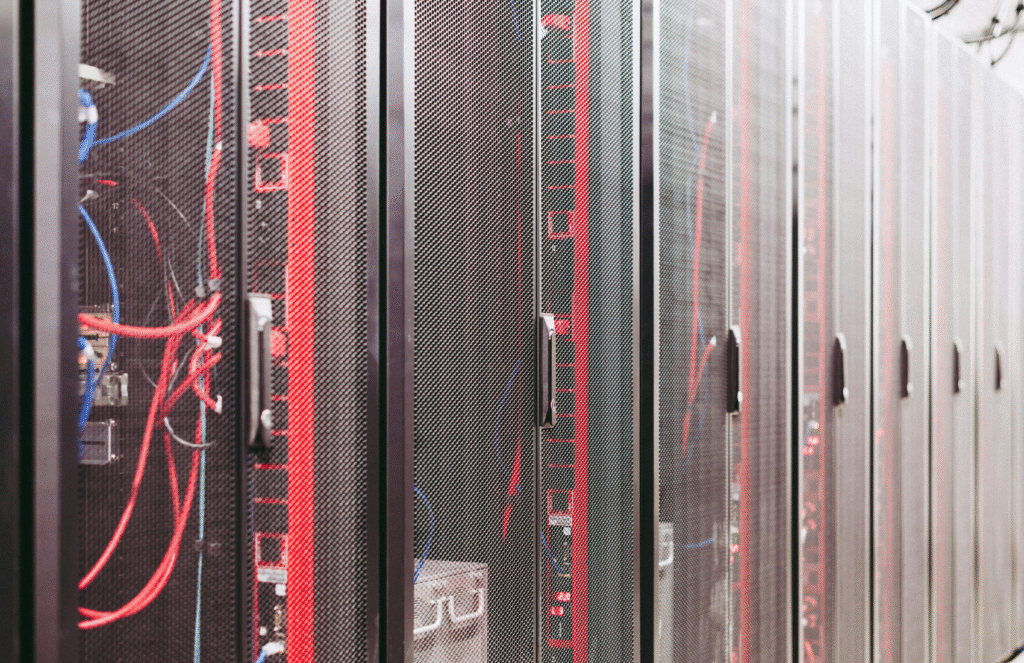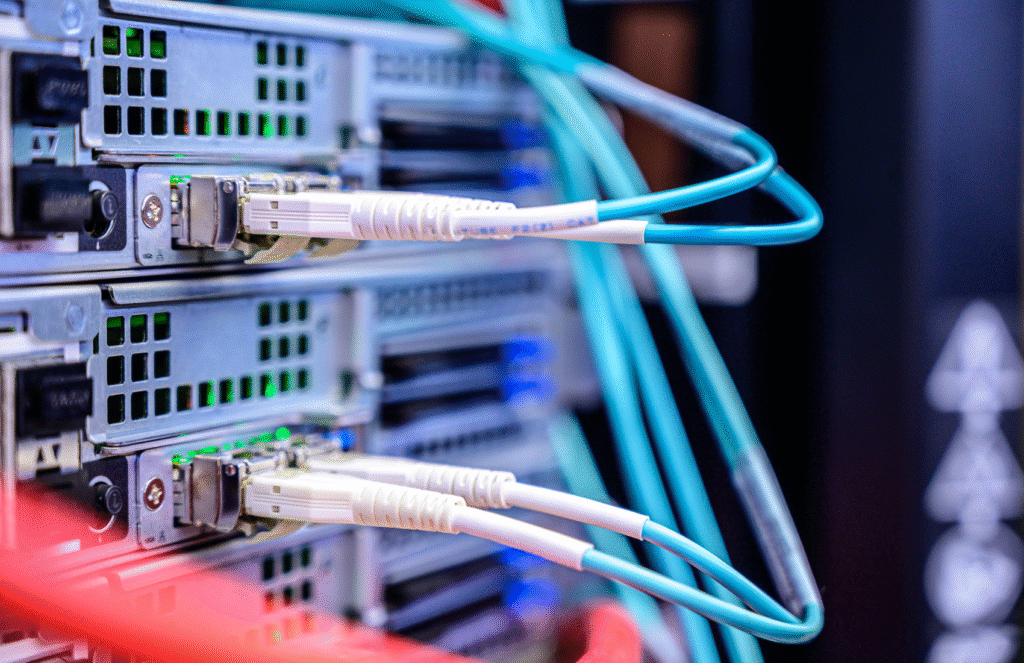When your company’s servers reach end-of-life, the question isn’t just where to put them – it’s how to protect years of sensitive data while complying with environmental regulations. After helping hundreds of businesses in the Edwardsville area safely retire their IT infrastructure, we’ve learned that server recycling is about much more than just getting rid of old hardware.
Whether you’re upgrading your data center, closing an office, or replacing outdated equipment, proper server disposal protects your business from data breaches, regulatory violations, and environmental liability. Here’s everything you need to know about responsible server recycling based on real-world experience helping businesses navigate this critical process.
Why Server Recycling Requires Special Handling
Unlike consumer electronics, business servers contain multiple layers of sensitive information and valuable materials that demand specialized processing.
Data Security Can’t Be Left to Chance
Every server we’ve processed contained remnants of business data, even after companies thought they’d wiped everything clean. Standard deletion doesn’t actually remove data – it simply marks storage space as available for overwriting. We’ve recovered supposedly “deleted” files containing customer records, financial data, and proprietary information from drives that businesses assumed were clean.
The consequences of improper data destruction are severe. Last year, we worked with a medical practice facing potential HIPAA violations after their old server ended up in a general electronics recycling facility without proper data destruction. The potential fines started at $50,000.
Regulatory Compliance Across Multiple Industries
Different industries face varying requirements for server disposal. Healthcare organizations must comply with HIPAA regulations, financial institutions face SOX requirements, and any business handling credit cards must meet PCI DSS standards. Government contractors often have additional security clearance requirements.
We’ve helped clients navigate compliance requirements across industries, and the common thread is documentation. Regulatory auditors want proof of proper data destruction and responsible equipment disposal.
Environmental Impact Beyond Standard Electronics
Servers contain higher concentrations of precious metals than typical electronics – gold, silver, platinum, and rare earth elements. A single rack-mounted server can contain $50-100 worth of recoverable materials. When multiplied across entire data centers, the environmental impact of responsible recycling versus landfill disposal becomes significant.
The Complete Server Recycling Process
Proper server recycling involves multiple steps that protect both your data and the environment.
Step 1: Data Inventory and Assessment
Before any physical handling, we work with clients to identify all data storage devices. This includes obvious components like hard drives and SSDs, but also backup batteries with memory, network cards with firmware, and even some power supplies that store configuration data.
Real-world example: A manufacturing company thought they’d identified all storage devices in their decommissioned servers. During our assessment, we found additional data on RAID controller cards they hadn’t considered. That oversight could have exposed proprietary manufacturing processes.
Step 2: Professional Data Destruction
We use approved data wiping standards for drives that will be reused, and physical destruction for drives containing highly sensitive data. Physical destruction involves industrial shredding that reduces drives to pieces smaller than a dime.
The documentation process: Every destroyed drive receives a certificate of destruction with serial numbers, destruction method, and date. This documentation proves compliance during audits and provides legal protection against data breach claims.
Step 3: Component Separation and Material Recovery
After data destruction, servers get carefully dismantled. Steel chassis, aluminum heat sinks, copper wiring, and circuit boards are separated for different recycling streams. This process recovers maximum material value while ensuring proper handling of any hazardous components.
Precious metal recovery: The circuit boards go to specialized facilities that can extract gold, silver, and platinum for reuse in new electronics. This recovery process is both environmentally beneficial and economically valuable.
Server Recycling Options for Different Business Needs
Based on our experience with various business types and sizes, here are the main approaches that work for different situations.
Professional IT Asset Disposition (ITAD) Services
Best for: Businesses with compliance requirements, large server deployments, or high-security needs
Full-service ITAD providers like CJD E-Cycling handle everything from pickup to final material processing. We provide detailed chain-of-custody documentation, certified data destruction, and environmental compliance reporting.
What to expect: Comprehensive inventory of all equipment, secure transportation, witnessed data destruction (if requested), and detailed reporting for compliance documentation. Costs typically range from $50-200 per server unit, depending on size and data destruction requirements.
Our experience: We recently helped a financial services company retire 40 servers during a data center consolidation. The project required witnessed destruction of all storage devices and detailed reporting for SOX compliance. The entire process took three days and provided the documentation needed for their annual audit.
Manufacturer Take-Back Programs
Best for: Businesses with significant equipment from major manufacturers like Dell, HP, or IBM
Major server manufacturers offer recycling programs for their equipment. These programs often provide credits toward new purchases and guarantee responsible recycling.
The reality check: Manufacturer programs can be slow and may not meet your timeline needs. We’ve seen businesses wait 6-8 weeks for pickup scheduling. Also, manufacturer programs may not provide the detailed data destruction documentation required for compliance.
Certified Local Recyclers
Best for: Smaller businesses with basic compliance needs and flexible timelines
Local recyclers certified for electronics processing can handle server recycling at lower costs than full ITAD services. However, ensure they can provide proper data destruction and documentation.
Due diligence required: Always verify certifications (R2 or e-Stewards), insurance coverage, and data destruction capabilities. We’ve seen businesses choose low-cost providers only to discover inadequate data security measures.
Data Destruction: Your Most Critical Decision
The most important aspect of server recycling isn’t the hardware disposal – it’s ensuring your data can never be recovered.
Understanding Data Destruction Levels
Basic wiping: Suitable for non-sensitive business data. Uses software to overwrite data multiple times according to industry standards.
Degaussing: Uses powerful magnetic fields to disrupt data on magnetic storage devices. Effective for traditional hard drives but not suitable for solid-state drives.
Physical destruction: Complete destruction of storage devices through shredding or crushing. Required for highly sensitive data and recommended for drives containing personally identifiable information.
Our recommendation: For most businesses, we recommend physical destruction for any drive containing customer data, financial information, or proprietary business data. The cost difference is minimal compared to the potential liability.
Documentation and Chain of Custody
Proper data destruction requires detailed documentation. This includes serial numbers of destroyed devices, destruction method used, date and time of destruction, and witnesses present.
Legal protection: This documentation serves as legal proof that you took reasonable measures to protect sensitive data. In the event of a data breach investigation, this documentation can be crucial for demonstrating due diligence.
Compliance Requirements by Industry
Different industries face specific requirements for server disposal and data destruction.
Healthcare (HIPAA)
Healthcare organizations must ensure complete destruction of any device that may have contained protected health information. This includes not just database servers, but any server that handled patient data, billing information, or administrative records.
Documentation requirements: HIPAA requires detailed records of data destruction methods and dates. Business associate agreements may also require specific destruction procedures.
Financial Services (SOX, GLBA)
Financial institutions face strict requirements for protecting customer financial data. Server disposal must include certified destruction of all storage devices and detailed audit trails.
Our experience: We work with several local banks and credit unions on their equipment disposal. The process always includes witnessed destruction and comprehensive reporting for regulatory compliance.
Government and Defense
Government contractors often have additional security clearance requirements for equipment disposal. This may include background checks for personnel handling the equipment and specific destruction procedures.
Environmental Benefits of Proper Server Recycling
The environmental impact of responsible server recycling extends far beyond keeping equipment out of landfills. EPA guidelines for responsible electronics recycling.
Material Recovery and Reuse
A typical server contains approximately 65% steel, 20% aluminum, 10% plastic, and 5% precious metals and other materials. When properly recycled, these materials offset the need for new mining and manufacturing.
Energy Savings Through Recycling
Manufacturing new electronics requires significantly more energy than processing recycled materials. Steel recycling uses 75% less energy than producing steel from raw materials, while aluminum recycling uses 95% less energy.
Hazardous Material Management
Servers contain small amounts of hazardous materials including lead, mercury, and brominated flame retardants. Proper recycling ensures these materials are handled safely rather than leaching into groundwater from landfills.
Planning Your Server Retirement Project
Successful server recycling requires advance planning, especially for larger deployments.
Timeline Considerations
Start planning server disposal at least 30 days before the equipment needs to be removed. This allows time for data backup verification, destruction scheduling, and compliance documentation preparation.
Rush situations: We can accommodate urgent timeline needs, but this may require premium pricing and may limit data destruction options. Plan ahead when possible.
Cost Budgeting
Server recycling costs vary based on several factors: number of units, data destruction requirements, pickup logistics, and compliance documentation needs.
Typical pricing: Basic server recycling ranges from $25-75 per unit. Add $25-50 per unit for certified data destruction. Compliance documentation and rush processing may add additional costs.
Staff Coordination
Server disposal often requires coordination between IT staff, security personnel, and facilities management. Plan for staff time during pickup and any witnessed destruction procedures.
Red Flags: What to Avoid
Based on our experience investigating improper server disposals, here are warning signs to avoid when selecting a recycling provider.
Unusually low pricing: Legitimate server recycling and data destruction require skilled labor and proper equipment. Significantly below-market pricing often indicates corners being cut on data security or environmental compliance.
Lack of certifications: Reputable recyclers should have R2 (Responsible Recycling) or e-Stewards certification. These certifications require third-party audits of data security and environmental practices.
No data destruction documentation: Any provider handling servers with storage devices should provide detailed certificates of data destruction. Verbal assurances aren’t sufficient for compliance or legal protection.
Unclear disposal methods: Ask specifically where your equipment will be processed and whether it might be exported to developing countries. Responsible recyclers can provide clear information about their downstream processing partners.
Making the Right Choice for Your Business
Server recycling decisions impact your business long after the equipment leaves your facility. The right choice balances cost, security, compliance requirements, and environmental responsibility.
For most businesses, working with a certified ITAD provider offers the best combination of security, compliance documentation, and environmental responsibility. While costs may be higher than basic recycling options, the protection against data breaches and regulatory violations justifies the investment.
At CJD E-Cycling, we’ve built our reputation on helping Edwardsville area businesses safely retire their IT infrastructure while meeting the highest standards for data security and environmental responsibility. Our R2 certification, comprehensive insurance coverage, and detailed documentation processes provide the protection your business needs.
Ready to safely dispose of your old servers? Contact CJD E-Cycling for a comprehensive assessment of your server recycling needs. We’ll help you develop a plan that protects your data, meets your compliance requirements, and demonstrates your commitment to environmental responsibility.


